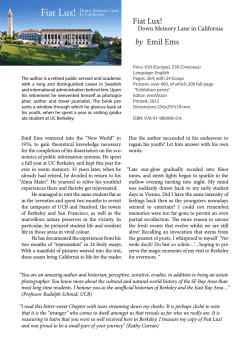
Quasiparticle and optical band gaps of Srn+
Quasiparticle and optical band gaps of Srn+1 Tin O3n+1 from ab initio many-body perturbation theory Sebastian E. Reyes-Lillo(1,2) , Tonatiuh Rangel(1,2) , Fabien Bruneval(1,2,3) and Jeffrey B. Neaton(1,2,4) (1) Molecular Foundry, Lawrence Berkeley National Laboratory, Berkeley, California 94720, USA (2) Department of Physics, University of California, Berkeley, California 94720 USA (3) CEA, DEN, Service de Recherches de M´etallurgie Physique, 91191 Gif-sur-Yvette, France (4) Kavli Energy NanoSciences Institute at Berkeley, Berkeley, California, 94720 USA The Ruddlesden-Popper (RP) homologous series Srn+1 Tin O3n+1 provides a unique opportunity to study the effect of dimensionality and confinement on the band gap and band edges states of the complex oxide SrTiO3 [1]. The structure of the n-th member of the RP series consists of a periodic stacking of n perovskite SrTiO3 monolayers separated by single SrO planes along one axis. As n becomes large, the structure converges toward bulk SrTiO3 . Experimental measurements have shown a decrease in the direct and indirect optical gaps, composed primarily of transitions between occupied O 2p and unoccupied Ti 3d states, as a function of n. Previous theoretical work [1] focused on the indirect gap and used density functional theory to reproduce the qualitative decrease of band gap as a function of n. In this work, we study the electronic and optical properties of selected members of the series (n=1-5 and ∞) quantitatively, calculating their direct and indirect quasiparticle band gaps using hybrid functionals and many-body perturbation theory within the GW approximation. Our GW calculations are in good agreement with measured direct optical gaps (Γ → Γ), suggesting that excitonic effects are modest in these materials. Our computed indirect GW gaps (M → Γ) overestimate reported optical gaps for small values of n but converge to experimental values at large n. Accounting for the electron-hole interaction via the Bethe-Salpeter equation approach for selected n, we compute ab initio optical gaps and spectra, and compare with experiment. [1] Lee et al., APL 102, 122901 (2013).
© Copyright 2025













